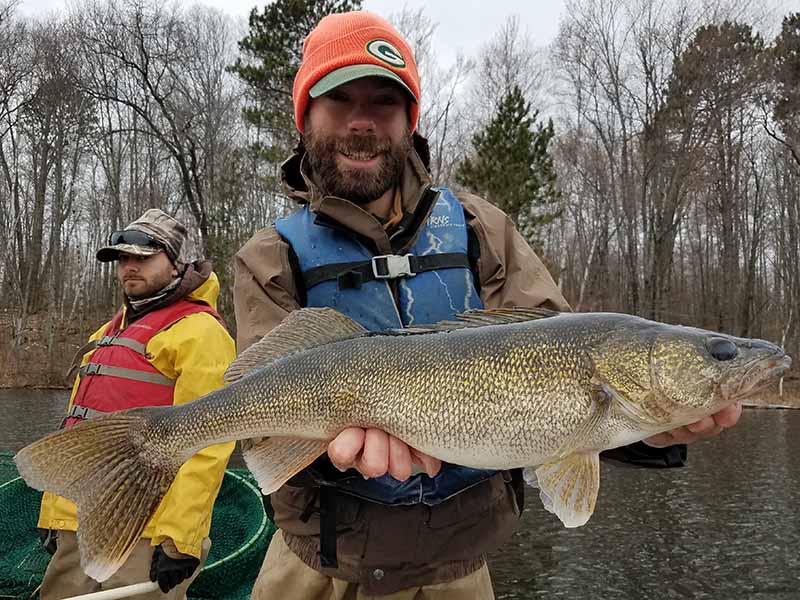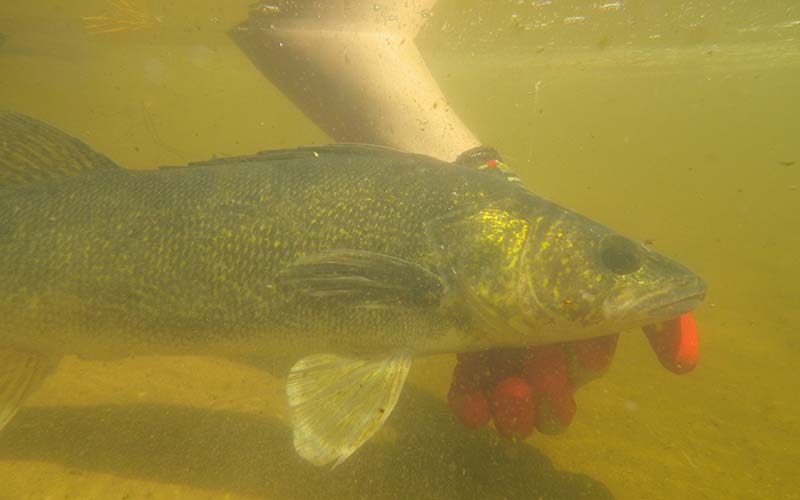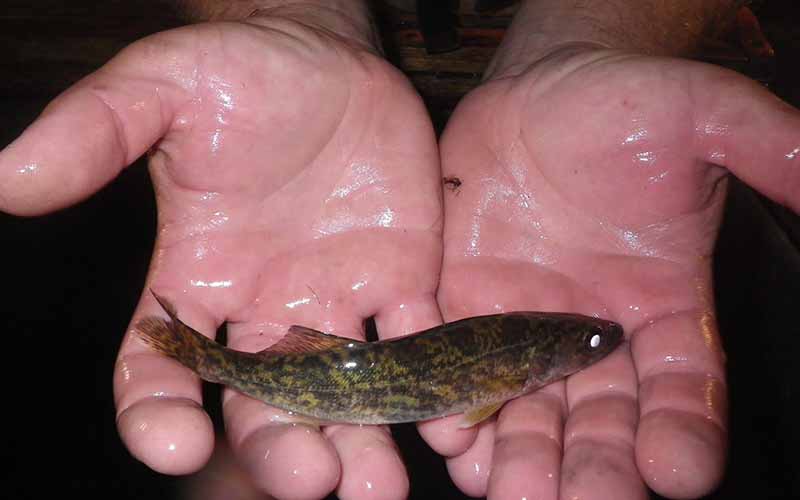Max Wolter is a fisheries biologist at the Wisconsin Department of Natural Resources.
What is your role/who are you?
I am a senior fisheries biologist with the Wisconsin Department of Natural Resources (WDNR), co-leader of the WDNR Walleye Management Team and coordinator of the update of the state walleye management plan.
What has been happening with walleye because of climate change?
Walleye are one of the most important species in Wisconsin. The species is highly prized by anglers, and generally prized as a harvest fish that people want to take home and eat compared to fish that people want to catch and release. Walleye are also very important to tribes of Wisconsin, primarily the Lake Superior Ojibwe.
Walleye are native to Wisconsin, especially the large rivers and some of the connected waters. Through stocking in the 19th and 20th centuries we have greatly expanded their range to include lots of lakes throughout the state, including northern Wisconsin. Much of the stocking was pretty successful; the fish took hold and began reproducing on their own in a lot of cases.

What’s happened in the last two decades is that we are seeing declines in the amount of successful natural reproduction. Lakes where they had been reproducing, they are not doing that successfully anymore. Even where they are successfully reproducing, it’s often happening at a lower level than the past.
That has huge implications for the number of walleye that are present in the water body. Naturally reproducing populations tend to have about twice as many adult walleye as the lakes we have to stock. Stocking is not as effective as what mother nature can do on its own when the conditions are right for the fish to reproduce.
We have a lot of research on the topic of climate change impacts on walleye populations. We know that as water warms, it becomes less favorable for walleye, which are a cool-water species. In a lot of cases the lakes are becoming clearer as the climate changes. That is generally not good for walleye. They are a low light predator that likes darker stained water, or water that is not ultra-clear.
As water becomes clearer and as lakes in particular become clearer, that habitat becomes less favorable for walleye and more favorable for some of their competitor species like largemouth bass, which are becoming more abundant at the same time that walleye are becoming less abundant.

Why are the lakes getting clearer?
It’s a variety of things. Sometimes changes in precipitation patterns can lead to changes in clarity. Some of it has to do with lakes becoming cleaner/clearer as pollutants are becoming less common. Since the Clean Water Act passed, we have seen some lakes turn around. That’s generally a good thing, but it is not always favorable for walleye.
There’s a very complex interplay of temperature, clarity, competitive species, and even invasive species like zebra mussels and rusty crayfish. There are interesting patterns with the amount of aquatic vegetation which is linked to temperature and clarity. The habitat is changing at a pretty rapid pace, in some cases, and a highly specialized cool-water fish like walleye are finding themselves on the outside looking in in a lot of places where they were doing pretty well in the past.
When you say habitat is changing pretty fast, what do you mean by that?
The warming water temperature is pretty significant. Just a few degrees of warming in our lakes can put walleye outside of the optimal range for successful reproduction. Consider that Wisconsin is really on the southern edge of where walleye have had their historic range, so we don’t have much margin for error when the water starts warming.
When you think about climate change and warming, what do you see for the future for walleye in Wisconsin?
It’s not a rosy picture. The modeling shows that we’re likely to continue to lose some of the walleye populations that had been naturally reproducing. Keep in mind, that’s on top of declines we’ve already seen over the last 20 to 30 years. By mid-century we’re going to have maybe half of the naturally reproducing walleye populations that we have today. I am hopeful that through research we are going to crack some of the intricacies of why walleye are not reproducing successfully.
For example, we know that there are a lot of female walleyes in the lakes and enough eggs and spawning rocks. The eggs being laid are being fertilized. There’s a bottleneck that the very tiny walleye can’t make through. Something is happening between April, when the eggs are laid, and fall.

One theory for the bottleneck is that when the walleye are hatching, if they hatch too early and the microscopic food is not available yet, they starve. The order of things that are supposed to happen are changing.
Another factor could be the extreme precipitation events are changing river habitat by filling up the holes for spawning and might be washing out some of the rocks that they spawn on. We also have potential disruptions from invasive species to eutrophication of lakes. All the different factors are coming together and acting against a fairly sensitive species.
Walleye are not tough. In the right conditions they can do well, but they are not tough when there are disturbances and changes in the environment. Once we identify details of what’s going on there, we may be able to develop tools to counteract it. In the meantime, we are going to have to stock a lot of fisheries and those are not going to be as high quality as if the walleye were reproducing on their own.
What’s being done to try and help walleye?
That’s really something we are focusing on with the update of the state walleye management plan. A lot of it comes down to watershed protection. We want to make sure we don’t have excessive nutrients that come into the lake and eat up oxygen, especially in the deeper water parts of the lake where walleye might like to spend their time. We are looking at shoreline erosion in places that walleye like to spawn.
Where would someone go if they want to play a role in helping walleye?
We’re hoping to create a resources page on the DNR website. We will have information for shoreline owners that show what a healthy shoreline looks like from a walleye perspective, from spawning habitat to minimizing nutrient inputs. If you’re an angler, we will have tools that help you make ethical decisions about how you fish for and harvest walleye.
In general, we need to have a better understanding of where the good walleye habitat is now and where it can be in the future so we can focus our efforts. If a walleye lake has lot of resilience to climate change, that is one we want to focus our efforts on and do everything we can to keep it in the best possible shape for these fish.
Do you have hope for the future?
Yes, I can find some hope, sure. We still have habitats where walleye are going to be well suited, like rivers and deeper lakes. Rivers are a little cooler than lakes and they have higher oxygen content that can give some refuge from climate impacts. We can try to make some positive changes through management strategies to benefit walleye.
There are still going to be cool places in Wisconsin to fish for walleye. Hopefully that will make people appreciate them even more and appreciate the sensitive nature of these things that we have taken for granted for a long time. We are going to have great fishing for lots of other species as well. We are going to have places to catch smallmouth bass, panfish, and lots of other species that are fun to catch and good to eat. Our lakes will never be empty, but we are seeing changes to what’s out there.
Learn More
- Wisconsin’s Walleye Management Plan – The Update (Wisconsin Department of Natural Resources)
The views and opinions expressed in this interview are those of the authors and do not represent official policy or position of the University of Wisconsin-Madison or the Wisconsin Initiative on Climate Change Impacts.
For More Information
Fisheries Biologist
Hayward Service Center
Bureau of Fisheries Management
Wisconsin Department of Natural Resources
(715) 634-7429
Max.wolter@wisconsin.gov